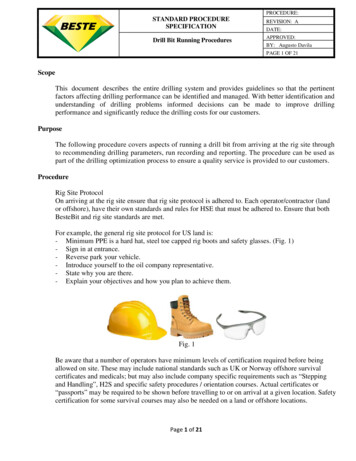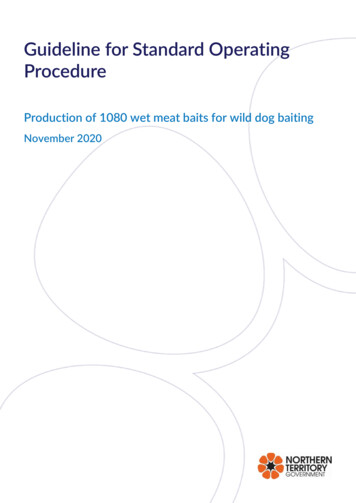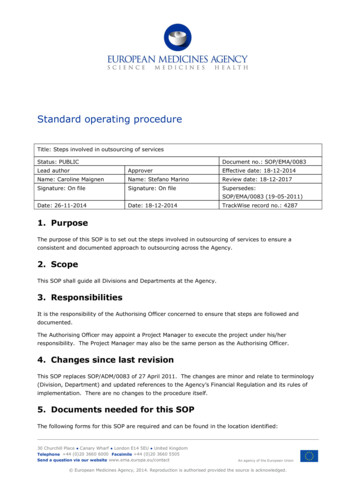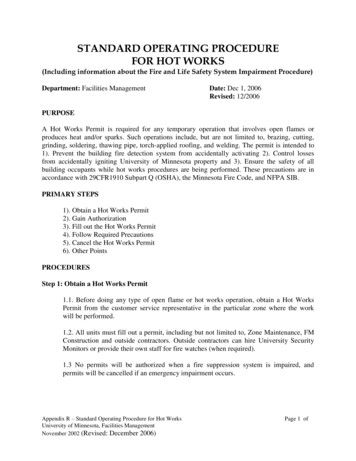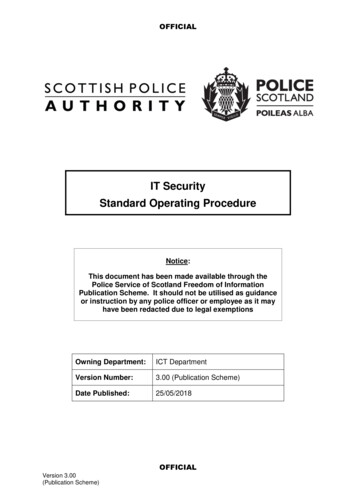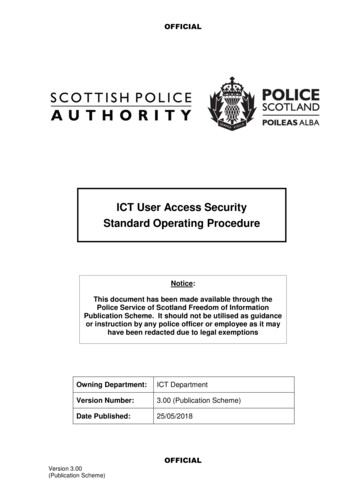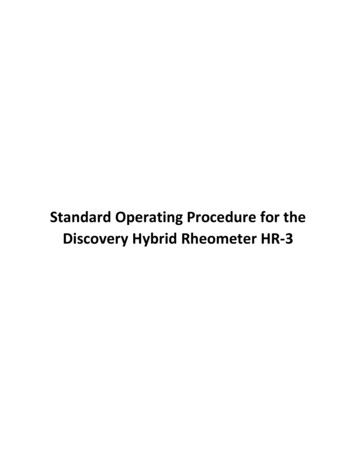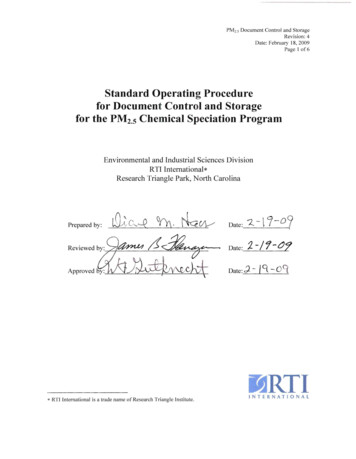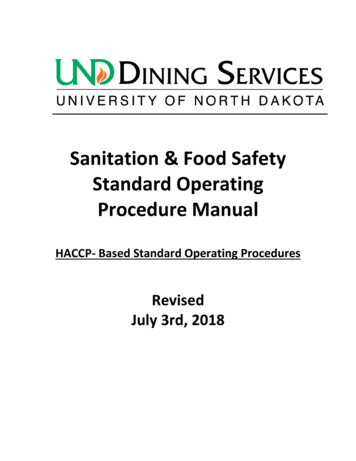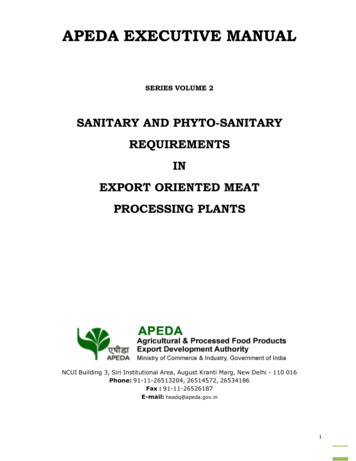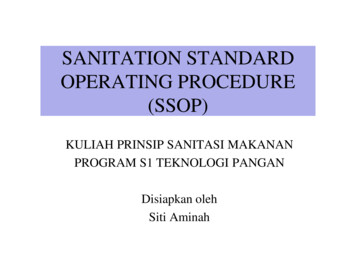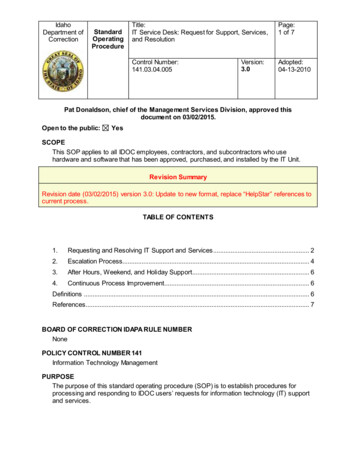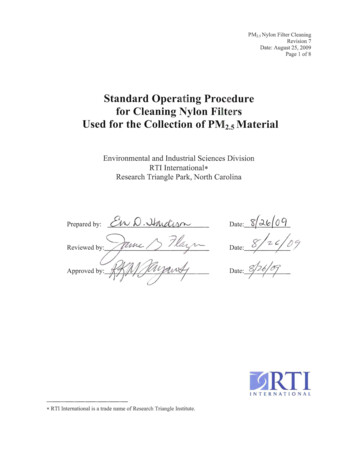
Transcription
PM 2 .5 Nylon Filter CleaningRevision 7Date: August 25,2009Page I of8Standard Operating Procedurefor Cleaning Nylon FiltersUsed for the Collection of PM2.5 MaterialEnvironmental and Industrial Sciences DivisionRTI Intemational*Research Triangle Park, North Carolina&v fJ . ()-.Jal/a- Reviewed by: Q Approved by: "/Prepared by:Date:Date:Date: (J.Jo (() qsh Jt; :7JC/. f1y ' RTIINTERNATIONAL* RTI International is a trade name of Research Triangle Institute.
PM2.5 Nylon Filter CleaningRevision 7Date: August 25, 2009Page 2 of 8ContentsSectionPage1.0Procedural Section .31.1Purpose and Applicability.31.2Summary of Method .31.3Health and Safety Warnings .31.4Cautions .32.0Apparatus and Reagents.43.0Filter Cleaning .43.1Cleaning Procedure.43.2Filter Acceptance Testing .64.0Quality Control .75.0References.7Attachment A .8
PM2.5 Nylon Filter CleaningRevision 7Date: August 25, 2009Page 3 of 8Standard Operating Procedurefor Cleaning Nylon FiltersUsed for the Collection of PM2.5 Material1.0Procedural Section1.1Purpose and ApplicabilityNylon filters are used for the collection of PM2.5 material in the chemical speciation particulatesamplers. These filters are analyzed for the following ions: nitrate, sulfate, ammonium, sodium,and potassium. The filters, as purchased and received from different manufacturers, showunacceptable levels of these ions, often exceeding the maximum level of 1 Fg per filter for aparticular ion. This has prompted the development of a procedure for cleaning the nylon filtersprior to their use for field sampling; this procedure is described in this standard operatingprocedure (SOP).1.2Summary of MethodFifty nylon filters are placed in a 2 L polypropylene jar with approximately 1000 mL of polisheddeionized water (18.2 MΩ-cm; water that has been passed through a secondary deionizationsystem). The filters are shaken in the water for approximately 2 minutes, and the water isdecanted and discarded. This process is repeated. The jar is then filled with polished deionizedwater and placed on a Toxicity Characteristic Leaching Procedure (TCLP) apparatus (TLCP,EPA SW-846 Method 1311). The jar is rotated for 7 to 8 hours, and the water is replaced withfresh polished deionized water. The jar is then rotated overnight for 14 to 16 hours before thewater is replaced again. After another 24 hours of washing, the water is drained from the filtersand the filters are dried. (The order of extended washing may vary; that is the sequence may be24 hours, 7 to 8 hours, and then 12 to 14 hours rather than 7 to 8 hours, 12 to 14 hours, and 24hours.) The filters are dried on glass racks in a convection oven set at 45EC. One filter out of 50is desorbed and analyzed by IC to test for residual contamination, prior to being approved forlater use.1.3Health and Safety WarningsThe PM2.5 filter-preparation operations do not involve unusual risks from electrical equipment orchemical exposures. Standard RTI laboratory health and safety precautions will be followed.1.4CautionsLaboratory personnel should always wear clean clothes and wash hands thoroughly beforeperforming filter handling and analysis procedures. The use of gloves rinsed with deionizedwater is required for all steps of the filter cleaning process because this will minimize thepotential for laboratory contamination.
PM2.5 Nylon Filter CleaningRevision 7Date: August 25, 2009Page 4 of 82.0Apparatus and ReagentsThe nylon filters used are Whatman 47 mm nylon membrane filters, 1.0 μm pore size (Whatmancatalog number 7410-004).The only reagent needed is polished deionized water (18.2 MΩ-cm; water that has been passedthrough a secondary deionization system).Several pieces of equipment are used for cleaning the nylon filters. Included are:1.2.3.4.5.6.2-L polypropylene wide-mouth Mason jars (VWR Catalog Number 16128-660 orequivalent)TCLP apparatus (TLCP, EPA SW-846 Method 1311) that holds six 2-L jars.Programmable timer (VWR Lab Controller or equivalent)Convection drying oven (VWR Model 1320 or equivalent)11'' x 11'' glass drying rack (custom made from 1/4'' glass rods in parallel rowsattached to 3/8'' glass rods serving as a frame; center-to-center distance for the1/4'' parallel glass rods is ½'')Plastic colander approximately 8'' in diameter from a kitchen appliance store.3.0Filter Cleaning3.1Cleaning ProcedureThe nylon filters are cleaned using the following procedure, which should be started at thebeginning of a work day. The date when the cleaning is started is entered into the log book andthe batch is identified by this date.1.Fifty 47-mm nylon filters are carefully removed from the manufacturer’s filtercontainer using either gloves or forceps. Each filter is separated with a blue tissuewhich is removed prior to placing the 50 filters into a 2-L polypropylene jar thatcontains approximately 1000 mL of polished deionized water. The lid is attached,and the jar is shaken gently for approximately 2 minutes. The water is thencarefully poured out of the jar without losing any filters. This rinse step isrepeated. The two-step rinse procedure is then duplicated with five additional 2-Ljars each loaded with 50 filters. Each jar is labeled with a letter (i.e., A, B, C),using a marker.2.Each jar is carefully filled with polished deionized water until it is overflowing; itis then capped tightly and placed on the TCLP apparatus. The apparatus is turnedon and mixes the filters and polished water by rotating the jars end-over-end. Itcycles until the end of the day (i.e., 7 to 8 hours). The water is carefully pouredout of each jar, and the jars are again filled to overflowing. The jars are placed onthe TCLP apparatus, turned on, and allowed to run overnight, or for 14 to 16
PM2.5 Nylon Filter CleaningRevision 7Date: August 25, 2009Page 5 of 8hours. At the beginning of the next work day, the water is poured out again andreplaced, and the jar is placed back on the apparatus for approximately 24 hours,or until the beginning of the next work day. Depending on a person’s workschedule, the order of the extended washing may be varied; that is, the sequencemay be 24 hours, 7 to 8 hours, and then 12 to 14 hours rather than 7 to 8 hours, 12to 14 hours, and 24 hours.Note: Because the filters tend to stick to the sides of the jars during rotation, theTCLP apparatus is connected to a timer that is programmed to rotate the jars for15 minutes, and then allow them to sit at rest for 2 minutes. During this restperiod, the filters that were stuck to the sides of the jar slip away and fall to thelower part of the jar of water. This timed cycle of rotation, followed by resting,continues through each cleaning period. The procedure for programming the timeis given in Attachment A.3.The jars are removed from the TCLP apparatus after the final wash and are takento a Class 100 clean room for drying of the filters. The lid of a jar is removed andthe water and filters are gently poured into a pre-rinsed plastic colander placed ina sink in the clean room. It may be necessary to add polished deionized water tothe jar several times to remove all of the filters. The excess water is allowed todrain from the filters and the colander for several minutes. Any filters that fallinto the sink during this process will be discarded.4.With gloves and a clean forceps, the filters are removed from the colander one byone and placed separately on the drying rack, which has been thoroughly prerinsed with polished deionized water shortly before use. The loaded rack iscarefully placed in the oven, which is set at 45EC. The filters are allowed to drycompletely. The filters sometimes curl slightly during the drying process. A largeamount of curling indicates that the oven temperature is too high. If so, slightlyreduce the temperature so the filters dry without curling.Note: The drying oven must be kept free of any dust or particulate material andshould only be operated in a clean environment. The oven should be visuallyinspected for any contamination prior to each use. A dedicated oven used only fordrying PM2.5 nylon filters is used.5.The dried filters are removed from the drying rack using clean forceps and areplaced back into the original manufacturer’s plastic containers. These containersare washed with deionized water and are dried before reuse. Filters will beinspected for pinholes and tears; any damaged filter will be discarded. Twentyfive filters are placed in each container. Each container is labeled with the batchnumber (i.e., start date for cleaning) and the jar identifier (i.e., A, B, C).
PM2.5 Nylon Filter CleaningRevision 7Date: August 25, 2009Page 6 of 83.2Filter Acceptance TestingOne filter from each set of dried filters is selected at random for analysis. Blank filters areanalyzed according to the analytical procedure described elsewhere in the SOPs for Anion(Hardison, 2008) and Cation (Hardison, 2008) analysis contained in the laboratory QualityAssurance Project Plan. For lot acceptance, the filter loadings of the ions of interest (i.e., sodium,potassium, ammonium, nitrate, and sulfate) must each be less than 1.0 Fg per filter. If any ionexceeds the limit, the entire lot must be rejected. Rejected lots may be re-cleaned using the sameprocedure.Each accepted batch of filters is assigned a unique number. Each filter’s batch number isrecorded in the PM2.5 database when it is loaded into a sample module in the Sample Handlingand Archiving Laboratory. The lot number can be used to trace the acceptance test results in casethere is a question about any filter.Note: Several different cleaning procedures were used during the course of the PM2.5Speciation Trends Network contract, which began in early 2000. This note summarizesthe procedures used for cleaning nylon filters prior to finalization of the methoddescribed in this SOP.Prior to March 28, 2000, filters were soaked three times for 30 minutes in deionizedwater without shaking or ultrasonication. Drying and acceptance procedures wereidentical to those previously described.Prior to December 1, 2001, filters were cleaned using a shaker for the final 24-hour washin deionized water. In fall 2001, some batches of filters received from the supplier werenoted to be partially disintegrating in the shaker. It was concluded that the filter’sdurability was somewhat variable, and that shaking for 24 hours was too forceful for theless durable filters; therefore, the more gently rolling method was adopted.Prior to December 1, 2002, filters were placed in a polypropylene jar of sodiumcarbonate/sodium bicarbonate solution (the eluent used for anion analysis). The jarcontaining the filters was placed in an ultrasonic bath for 1 hour. The filters were thenrinsed three times with deionized water, rinsed gently using a jar roller mill in deionizedwater for about 1 hour, rinsed again manually three or four times, and then rinsed gentlyin fresh deionized water for 24 hours using the jar roller mill. This procedure wasabandoned for the following reasons: the ultrasonic bath sometimes caused partialdisintegration of the filters, sodium from the eluent solution was sometimes still presenton the filters, and the TCLP apparatus was better than a roller because it provides endover-end mixing. The method described in this SOP was subsequently adopted.
PM2.5 Nylon Filter CleaningRevision 7Date: August 25, 2009Page 7 of 84.0Quality ControlThe quality control activities include the following:1.Perform ion analyses of the polished deionized water whenever the deionizer bedsare changed to determine that the ions of interest are below their maximumallowable concentration, as presented in Table 1. Replace the ion exchange bedsin the water deionization system if these limits are exceeded.Table 1. Maximum Allowable Concentration (MAC) for Ions of InterestIon of InterestNitrateSulfateAmmoniumSodiumPotassiumMAC, Fg/mL0.010.010.010.010.022. Keep all jars closed and stored in a clean environment when not in use.3. Periodically wipe down the inside of the drying oven with wet, lint-free tissues.5.0ReferencesHardison, E. 2008. Standard Operating Procedure for PM2.5 Anion Analysis. Quality AssuranceProject Plan Chemical Speciation of Particulate Matter, Volume II, Appendix A-5.1,revision 6.Hardison, E. 2008. Standard Operating Procedure for PM2.5 Cation Analysis. Quality AssuranceProject Plan Chemical Speciation of Particulate Matter, Volume II, Appendix A-5.2,revision 6.
PM2.5 Nylon Filter CleaningRevision 7Date: August 25, 2009Page 8 of 8Attachment AMethod for Programming the VWR Lab ControllerThe device is programmed for the repeat mode, which permits repeatedly turning equipment onor off at one or two unique time intervals.1.Press the CHANNEL SELECT key until the OUTLET ch
25.08.2009 · (Hardison, 2008) and Cation (Hardison, 2008) analysis contained in the laboratory Quality Assurance Project Plan. For lot acceptance, the filter loadings of the ions
